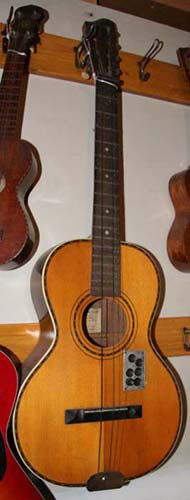| Author |
Topic: 1916 Tonaharp - earliest steel guitar changer mechanism? |
Bill Sinclair
From:
Waynesboro, PA, USA
|
 Posted 7 Apr 2019 8:31 pm
Posted 7 Apr 2019 8:31 pm |
|
Long before the Gibson Electrharp, the Multikord or the National Triplex there was this thing, the E.D. Wilbur Co. 7-String Tonaharp Guitar. It had five or six pushbuttons mounted to the top of the guitar that operated a changer on the tailpiece behind the bridge. The link is to the single page website put up by the creator's grandson. A comparison of the patent (applied for in 1916) and the 1916 manual for the guitar (pgs. 14,15 & 16) shows some differences in execution but it's clearly a string-pull mechanism for changing the tuning on a guitar intended to be played with a steel. Anybody know of an earlier one?
http://www.laverneandmark.com/tonaharp/?tonaharp

Last edited by Bill Sinclair on 7 Apr 2019 8:36 pm; edited 2 times in total |
|
|
 |
Bill Sinclair
From:
Waynesboro, PA, USA
|
|
|
 |
Ian Rae
From:
Redditch, England
|
 Posted 8 Apr 2019 12:38 am
Posted 8 Apr 2019 12:38 am |
|
I've said this before, but there are strong parallels with the development of valves of brass instruments. Natural trumpets and horns have a peculiarly penetrating and sonorous tone which caused frustration at the limited notes available. So from the early 1800s the experiments began - how to increase the choice of notes without spoiling the sound. The modern French horn is a Bb/F universal!
_________________
Make sleeping dogs tell the truth!
Homebuilt keyless U12 7x5, Excel keyless U12 8x8, Williams keyless U12 7x8, Telonics rack and 15" cabs |
|
|
 |
Bill Sinclair
From:
Waynesboro, PA, USA
|
 Posted 8 Apr 2019 10:40 am
Posted 8 Apr 2019 10:40 am |
|
| Ian Rae wrote: |
| I've said this before, but there are strong parallels with the development of valves of brass instruments. |
Yes, I always get stuck in the musical instruments collection wing at the Met in NYC just marveling over the development of instruments over hundreds of years.* Valve instruments are some of the craziest. I have to think that this would be the earliest changer on a steel guitar though. Do you know of any examples of a string pitch changer on conventional guitars, zithers etc. contemporary to or predating this one? Besides the tuning peg of course. 
*I just saw that this exhibit is currently closed, presumably for the "Instruments of Rock and Roll" exhibit running from today through Oct 1st. Louis Jordan's alto, Clapton's Blackie, guess I'm taking another trip to the city! |
|
|
 |
Bill Groner
From:
QUAKERTOWN, PA
|
 Posted 8 Apr 2019 11:37 am
Posted 8 Apr 2019 11:37 am |
|
Bill have you been to Martin Guitar Museum? Very interesting.
_________________
Currently own, 6 Groner-tone lap steels, one 1953 Alamo Lap steel, Roland Cube, Fender Champion 40 |
|
|
 |
Nelson Checkoway
From:
Massachusetts, USA
|
 Posted 10 Apr 2019 1:02 pm
Posted 10 Apr 2019 1:02 pm |
|
| Earliest string pitch changer would probably be on a Pedal or Concert Harp. I think the first "modern" system dates back to the early 1800s. Interesting that they change pitch by varying not string tension but string length. I think the way they work is that the pedals activate a disk that touches the string and acts like a fret to shorten it and raise pitch (or pull the disk away to lower the note). |
|
|
 |
Ian Rae
From:
Redditch, England
|
 Posted 10 Apr 2019 2:29 pm
Posted 10 Apr 2019 2:29 pm |
|
Yes, I think one of the earliest uses of the modern orchestral harp was in the Fantastic Symphony by Berlioz (1830) and Nelson is right about how it works. A little disc with two prongs shortens the string from flat to natural when the pedal's half down then to sharp when it's down all the way. There are seven pedals, one for each note of the scale. The tone of the open strings is best so if for instance the orchestra is playing in B, the harp would be written in Cb.
_________________
Make sleeping dogs tell the truth!
Homebuilt keyless U12 7x5, Excel keyless U12 8x8, Williams keyless U12 7x8, Telonics rack and 15" cabs |
|
|
 |




